How Many Golf Balls Does A Pro Hit A Day
How Many Golf Balls Does a Pro Hit a Day? A pro golfer hits about 500 to 1,200 golf balls a day, depending on what they’re working on. This includes hitting full shots on the driving range, short chips, and putting practice.
Most of the time, they practice for 4 to 6 hours a day, but not all at once. They take breaks and work on different parts of their game.
As a golfer, I hit a lot of balls, but not just for fun. I usually hit 500 to 1,200 golf balls a day when I’m practicing hard. If I’m getting ready for a big tournament, I might lower that to 200 to 400 balls, just to stay fresh.
Golfers like Tiger Woods used to hit over 1,000 balls daily. Others, like Scottie Scheffler, focus on smaller, smarter practice sessions using tools like launch monitors and help from their swing coach.
So it’s not just about hitting a lot of balls. It’s about smart practice. They work on swing speed, clubface control, and hitting the ball the same way every time.
Even though the number sounds big, every shot has a reason; that’s what makes pros so good.
How Many Golf Balls Does a Pro Hit a Day: The PGA Tour Truth
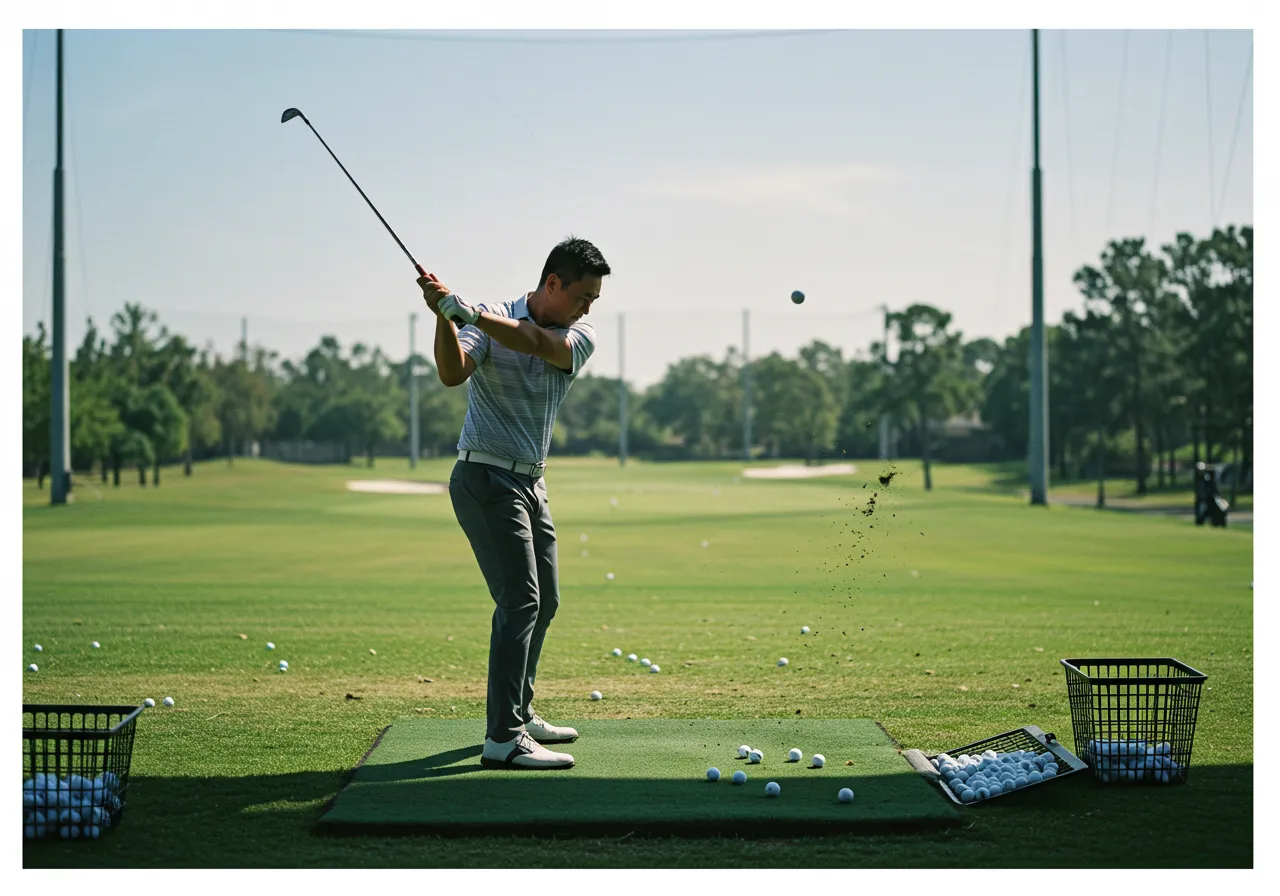
While amateurs obsess over ball counts, Tiger Woods’ 1,200-ball practice days reveal why quality trumps quantity.
Elite PGA and LPGA professionals hit 500 to 1,500 golf balls per day during intensive practice weeks. In tournament weeks, that number drops to 200–400 balls to prevent fatigue and maintain performance.
This depends on their swing training goals, recovery time, and how much focus is placed on the short game, not just full swings.
Table: About How Many Golf Balls Do Pro Golfers Hit Per Day in Training vs Tournament
| Player / Source | Practice Type | Balls Hit Per Day | Notes |
| Tiger Woods (peak years) | Off-season training | 1,000–1,500+ | Included full swing reps, chipping, and extensive putting work |
| Scottie Scheffler | Pre-tournament warm-up | 60–90 | Focuses on rhythm and shot shaping across wedges to the driver |
| Average PGA Tour Pro | Regular practice day | 500–1,200 | Includes full-swing, short game, and putting over 4–6 hours |
| LPGA Tour Pro (training) | Technical swing session | 400–900 | Often includes dedicated short game blocks and launch monitor feedback |
| Korn Ferry / Lower Tours | Mixed training schedule | 300–800 | Varies based on schedule, physical limits, and coaching strategy |
| Amateur Golfer (Range Day) | Casual practice | 50–200 | Based on Reddit & GolfWRX community feedback |
| Junior Elite (College/NCAA) | High-performance training | 300–600 | Often supervised by coaches; includes drills, not just full swings |
Note: This table shows typical ball counts hit daily by pro golfers and high-level amateurs.
How many golf balls do professional golfers hit daily during training sessions
From my experience on tour, most professionals hit around 800 to 1,200 balls on high-volume training days.
These aren’t hit all at once; we space them out over a 4 to 6-hour practice block, with plenty of rest and movement in between.
When we’re not competing, we use these days to work on:
- Ball-striking consistency
- Clubface control
- Shot shaping and tempo
- Wedge distance control
- Launch angle and spin
All of these matter more than just hitting a lot of balls.
What does a typical daily golf practice routine look like for a tour player

A full practice day is broken into blocks. Here’s how mine usually goes:
- Warm-up session: Stretching, swing tempo drills, and 30–50 short wedge shots
- Full swing practice: Around 400–700 balls with irons, woods, and the driver
- Short game work: 100+ chips, bunker shots, and pitch shots from different lies
- Putting drills: Focus on green speed, alignment, and stroke mechanics
The rest of the time is spent reviewing swing data using launch monitors, slow-motion video, and input from my swing coach.
How many golf balls do pro golfers hit before a tournament round
On tournament days, our warm-up is shorter and more controlled. I usually hit:
- 10–15 wedges
- 5–10 mid-irons
- 5 woods
- 5–10 driver swings
That totals about 60 to 100 balls, just enough to find my feel and rhythm. It’s not about volume, it’s about warming up smart and saving energy for the round.
Why do PGA Tour players hit hundreds of balls but focus on quality over quantity
A lot of beginners think pros hit thousands of balls just to get better. But the real difference is that every shot has a goal. We don’t just swing, we:
- Practice specific shot shapes
- Train for predictable distance control
- Use data feedback for adjustments
- Target areas where performance dropped in the last round
Even Tiger Woods, known for hitting over 1,000 balls a day, practiced with precise goals and real-time adjustments.
Does hitting more golf balls each day help you become a better player
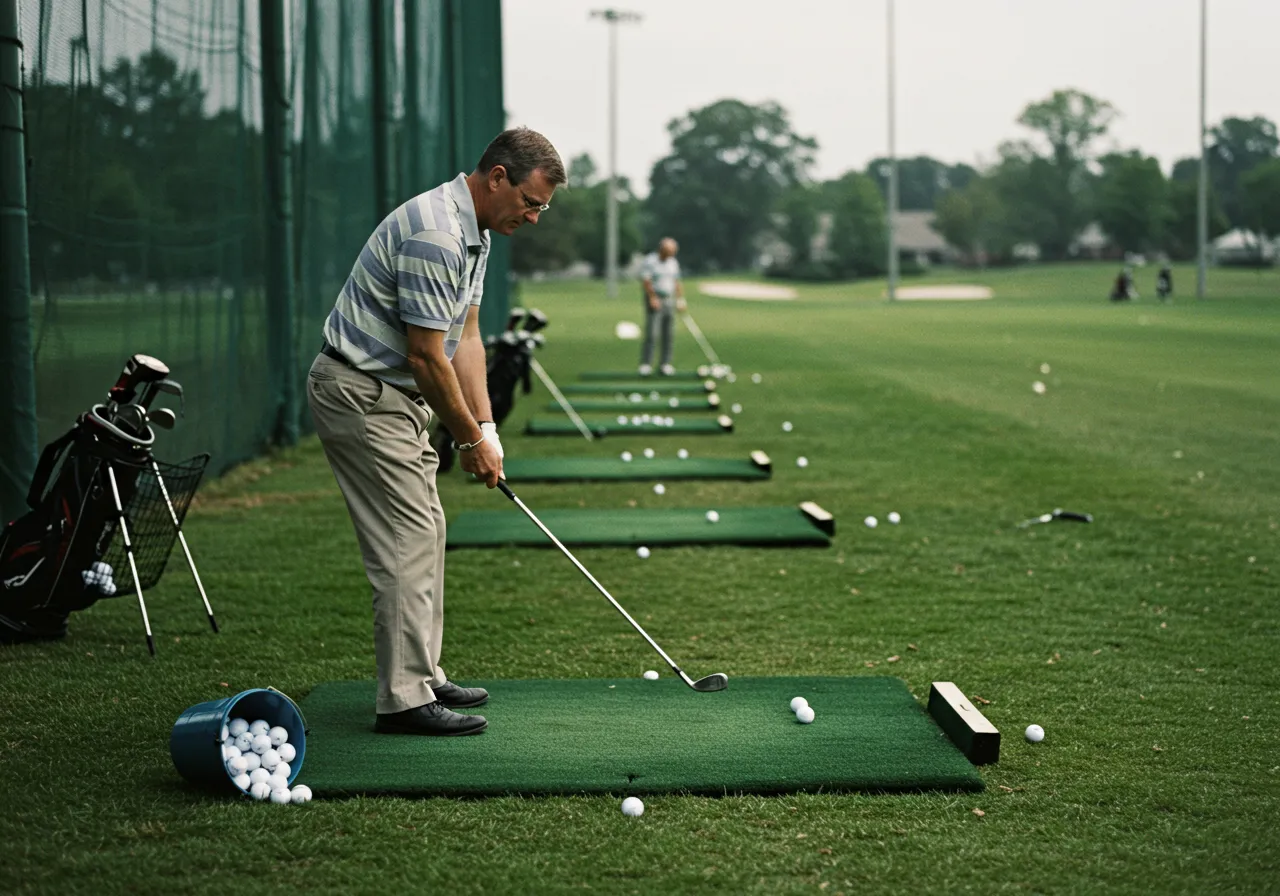
Not always. If you’re just swinging to hit a number, you might be building bad habits.
A beginner might hit 200 balls in a session, but if 150 are mis-hits without correction, progress will be slow.
It’s better to hit 100 well-focused shots, checking:
- Ball flight
- Contact quality
- Alignment
- Shot outcome vs intention
That’s how pros train, with structure, feedback, and purpose. Not just with high volume.
What do golf pros use to track practice performance during high-volume days
To avoid wasteful practice, we use:
- Launch monitors to track swing speed, spin rate, and carry distance
- Video replay to slow down mechanics and body movement
- On-course stats to guide our range focus
- Swing journals to track what worked, what didn’t
Every shot has a reason. Whether it’s 300 or 1,000 balls, the goal is always progress, not just reps.
How many golf balls should you hit a day if you’re not a pro
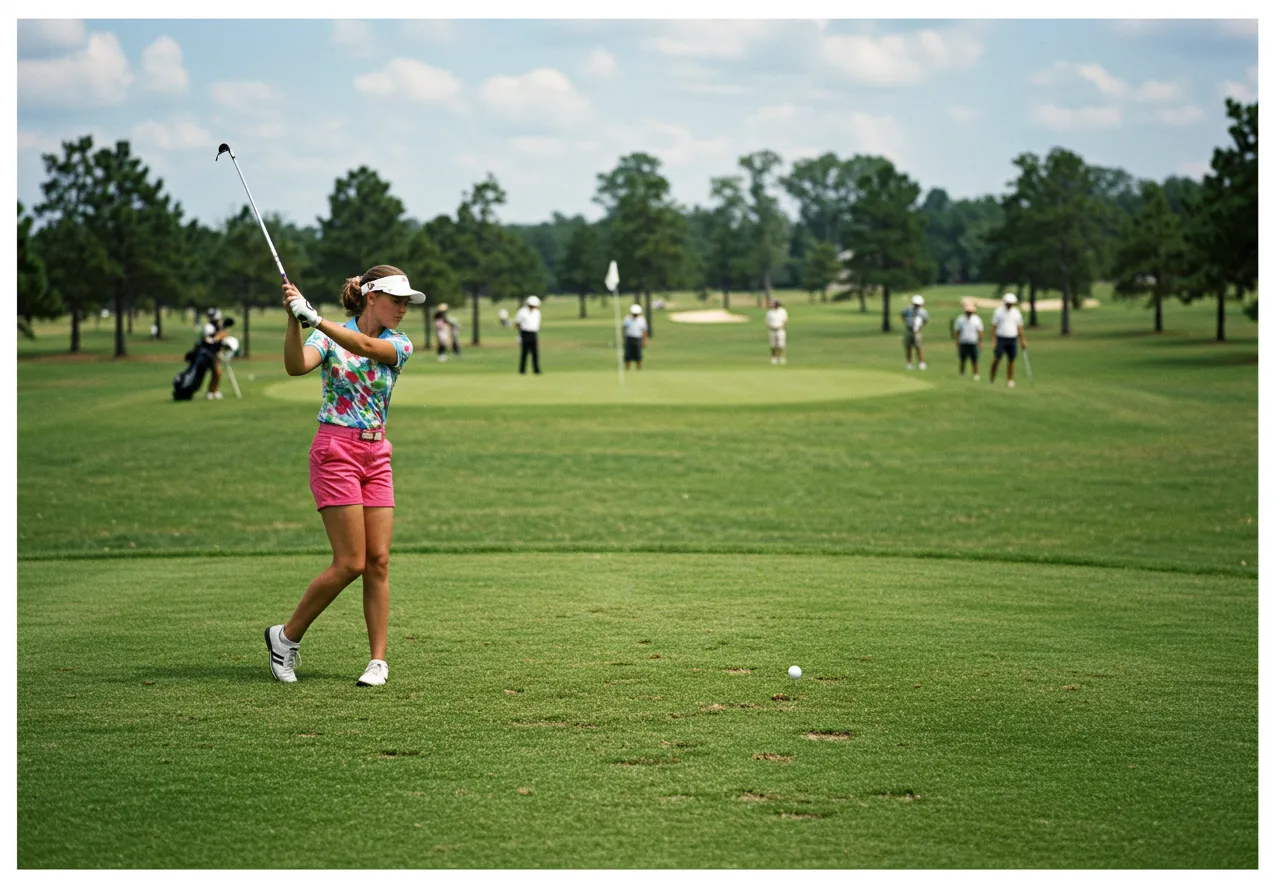
If you’re not a tour pro, don’t copy our ball counts. Instead:
- Focus on hitting 50 to 100 purposeful balls
- Mix up wedge shots, iron work, and driver practice
- Spend time on chipping and putting, where most strokes are gained
Start with smart practice, not long practice. If you train like the pros with purpose and feedback, you’ll improve faster than if you just hit for hours without a plan.
The Anatomy of a Pro’s Daily Practice Routine of Playing Golf
As a professional golfer, I practice changes depending on the time of year and what I’m working on.
Some days I focus on fixing my swing, and other days I’m getting ready for a tournament. But every day has a clear plan, not just random shots.
How many golf balls do pros hit daily during tournament prep vs. off-season training
When I’m preparing for a tournament, I usually hit 200 to 400 balls a day. These are focused shots to warm up my swing, work on distance control, and keep my rhythm sharp.
I spend more time putting and chipping than hitting full drivers.
But during the off-season, I sometimes hit up to 1,200 balls in a day. This is when I make bigger changes, like when Rory McIlroy worked on his driver setup a few years ago.
During those sessions, I’m trying new moves, testing different feels, and working with my swing coach using tools like launch monitors.
How is a pro golfer’s daily practice structured from warm-up to shot simulations

My practice isn’t just about hitting ball after ball. It’s broken into different parts to train every part of my game:
- Warm-Up Drills:
I start by stretching and swinging slowly with wedges to get loose. - Short Game Practice (about 60% of my session):
I hit chip shots, bunker shots, and putts. These are the shots that save strokes during real rounds. - Full Swing Work:
I move on to mid-irons, then long irons, and finish with a driver. Here, I focus on clubface control, launch angle, and shot shaping. - Shot Simulations:
I practice like I’m on the course, hitting a driver, then a 7-iron, then a pitch, just like a real hole.
Many Reddit users have shared that they use a 3:1 short game to driver practice ratio, and that’s something I do too. Most of my improvement comes from around the green, not just long drives.
Why quality matters more than hitting thousands of balls per day
Even if I hit 1,000 balls, I don’t just swing to hit a number. I think about every shot:
- What shape do I want?
- Where is my target?
- How does the contact feel?
This is what turns practice into real improvement, not just swinging hard, but practicing smart. That’s the difference between a pro and someone just hitting for fun.
Tiger Woods and Modern Pros: Real Practice Routines With Golf Balls That Changed the Game
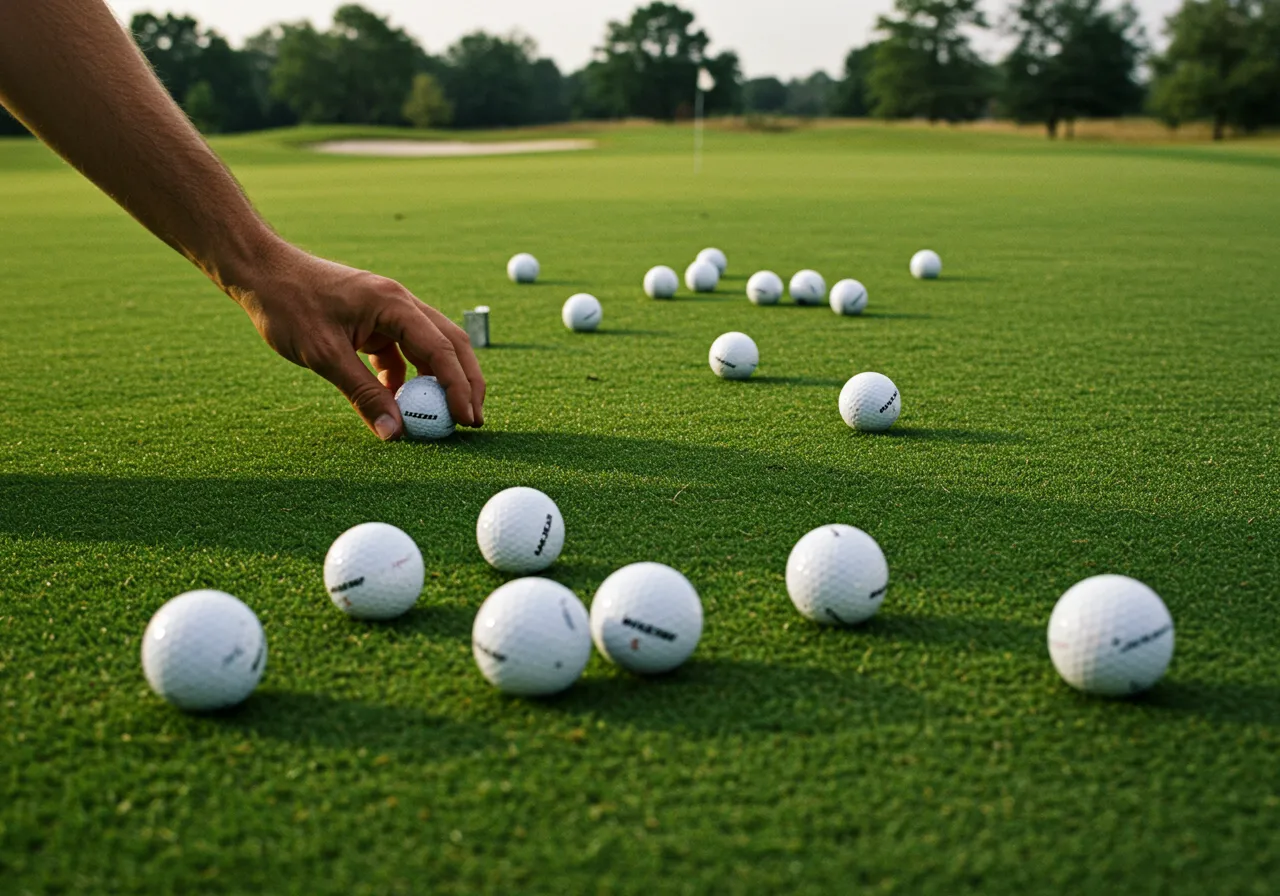
Watching how Tiger Woods trained and how players like Scottie Scheffler practice today taught me that how you practice matters even more than how much.
Let me share what I’ve learned from their routines and how I’ve used some of those habits in my own game.
How many golf balls did Tiger Woods hit daily during his peak years
Back in his prime, Tiger Woods used to hit 800 to 1,200 golf balls a day. After the range, he’d spend three more hours on the putting green.
That’s almost a full-time job, and it was all part of his plan to become the best.
He didn’t just hit balls; he worked on ball-striking control, swing tempo, spin control, and green reading.
And he did it at real practice facilities like the Isleworth Golf & Country Club or Medalist Golf Club, where conditions matched the PGA Tour.
How many golf balls does Tiger Woods hit today after his injuries
Now, after multiple surgeries, Tiger’s body can’t handle the same volume. His team helps him manage his load.
He hits about 300 balls max in a session, focusing on warm-up drills, short-game touch, and limited full swings.
His routine is now about:
- Recovery time
- Smart repetitions
- Rest between sessions
Even with fewer swings, he still works on clubface awareness and distance control, because quality reps matter more than high volume.
How does Scottie Scheffler warm up with golf balls before a tournament round

When I watched Scottie Scheffler prepare during a PGA event, I noticed he follows a 45-minute wedge-focused warm-up.
He starts with feel shots, hitting pitching wedges and sand wedges to targets between 30 to 100 yards. This gets his rhythm going without overloading his body.
He believes in something his caddie once said on GolfWRX:
“Feel over fatigue.”
That means:
- Practicing with a calm rhythm
- Avoiding muscle strain before the round
- Focusing on contact, not just distance
This method helps him stay sharp and confident without burning out.
What I learned from Tiger and Scottie’s routines as a pro golfer
I’ve tried both styles. Some days I’ll train like young Tiger, high volume, high effort, grinding through hundreds of balls.
But as I’ve gotten smarter, I follow more of the Scheffler model:
Hit fewer shots, but make every one count.
I now focus more on:
- Shot simulation drills
- Short game reps
- Pre-round tempo work
And just like them, I know that the secret isn’t hitting more, it’s hitting better.
Practice Routines of Top PGA Tour Players: Tiger Woods vs. Scottie Scheffler
| Player | Training Phase | Balls Hit Per Day | Focus Areas | Practice Duration | Notes |
| Tiger Woods (Prime) | Off-season/peak career | 800–1,200+ | Full swings, shot shaping, putting, and tempo control | 6–8 hours total | Included ~3 hours putting after range sessions; trained at elite clubs |
| Tiger Woods (Current) | Post-surgery load management | Max 300 | Short game, limited full swings, feel drills | 2–3 hours max | Reduced reps, more focus on recovery, and precision |
| Scottie Scheffler | Pre-tournament warm-up | 60–90 (plus putts) | Wedge control, tempo, confidence shots | ~45 minutes warm-up | Uses a 45-minute wedge session to prep the rhythm before teeing off |
| Modern Pro Average | Mid-season practice | 500–1,000 | A mix of range work, short game, and simulated rounds | 4–6 hours | Structured by performance goals and swing adjustment needs |
Note: This table shows how even the best golfers in the world vary their practice volume and style based on health, performance goals, and tournament demands.
Why Do Pro Golfers Hit 10 Times More Balls Than Amateur Players

People often ask why pros like me hit so many more golf balls each day compared to the average golfer. It’s not just about hitting longer drives.
We train more because we’re working on small details, swing shape, timing, ball flight, things you can’t fix in just a few swings. And there’s real science behind it.
Why repetition in golf helps improve swing mechanics and ball-striking consistency
When I hit hundreds of balls a day, it’s not just for fun. Repeating the same swing over and over helps build something in my brain called the myelin sheath.
That’s the part that helps you remember movements and do them better every time. It’s how you build a repeatable golf swing.
Each time I swing:
- I focus on the clubface angle
- I watch how the ball launches and curves
- I check my swing path using video or TrackMan data
TrackMan tells me how fast the ball travels, how high it launches, and where it would land. That feedback helps me make small changes that improve my swing faster than guessing.
How pros use swing repetition differently from casual golfers
Amateurs might hit 50 to 100 balls at the range, but they often just swing without a plan. I may hit 800 or more, but every set of 10 balls has a purpose:
- One set for fade control
- One for the wedge distance
- One for the launch angle
That’s how I train for ball-striking consistency. The more I practice with feedback, the less I rely on luck when I play.
How pro golfers avoid injury while hitting hundreds of balls per day
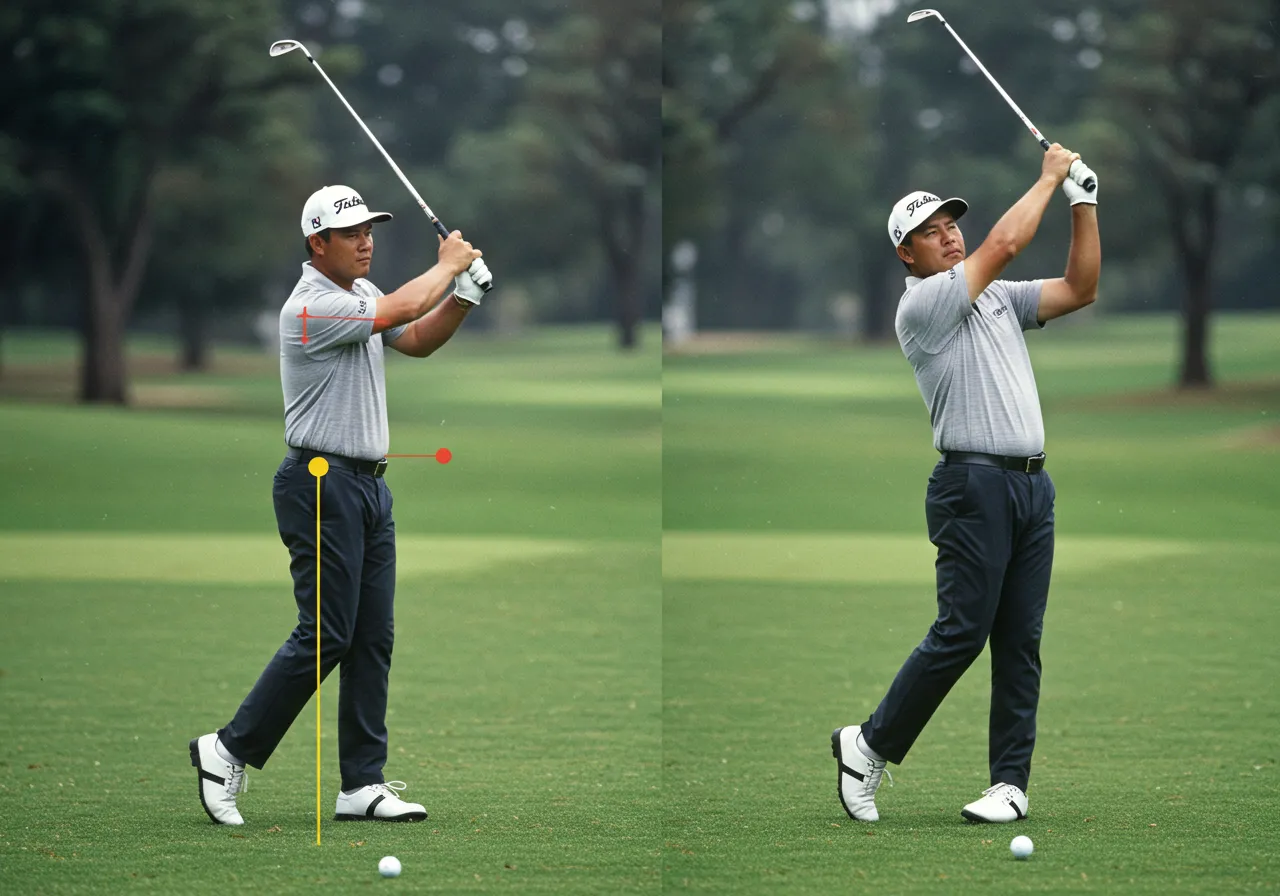
One thing I’ve learned the hard way is this: more swings mean more stress on the body. That’s why injury prevention is a big part of our training.
I’ve worked with PGA Tour physio teams, and they track things like:
- How many swings do I take per hour
- How much pressure is on my lower back or elbows
- When I need rest, no more reps
They taught me that load management matters more than ball count. Some players develop tendonitis in their elbows or lumbar spine stress from overuse, especially if their technique is off.
That’s why I take breaks, stretch, and sometimes hit fewer balls. Practicing smart keeps me playing longer.
What amateur golfers can learn from pro-level repetition and injury control
If you’re not a pro, you don’t need to hit 1,000 balls. But you should:
- Focus on every shot
- Use tools like alignment sticks and video
- Stop if you feel tired or sore
Even just 50 focused swings can help you improve, as long as you listen to your body and practice with a plan.
How Do Golf Balls Go from the Factory to the PGA Tour
A lot of people think golf balls just show up at tournaments, but there’s a huge system behind it.
As a pro, I’ve toured the factories, worked with ball reps, and seen how companies like Titleist and Callaway make sure we have exactly what we need, whether it’s for range practice or a major tournament.
How many golf balls are made daily by Titleist and Callaway for pro and amateur players
At the Titleist ball plant in Perry, Ohio, over 1.2 million golf balls are made every day. That number blew my mind the first time I visited.
These balls are built to tight standards; everything from spin rate to compression is tested.
Callaway also makes around 750,000 balls a day, using high-tech machines that check for shape, cover quality, and distance control.
Most of these balls go to everyday golfers, but a special batch, usually Pro V1 or Chrome Soft X, is sent to Tour players like me.
Each time I go to a tournament, Titleist gives me a fresh supply, sometimes marked with my initials or number preferences.
These aren’t off the shelf, they’re tour-tested balls, and I always use new ones during competition.
How does the wear and tear on golf balls impact how often pros replace their golf balls
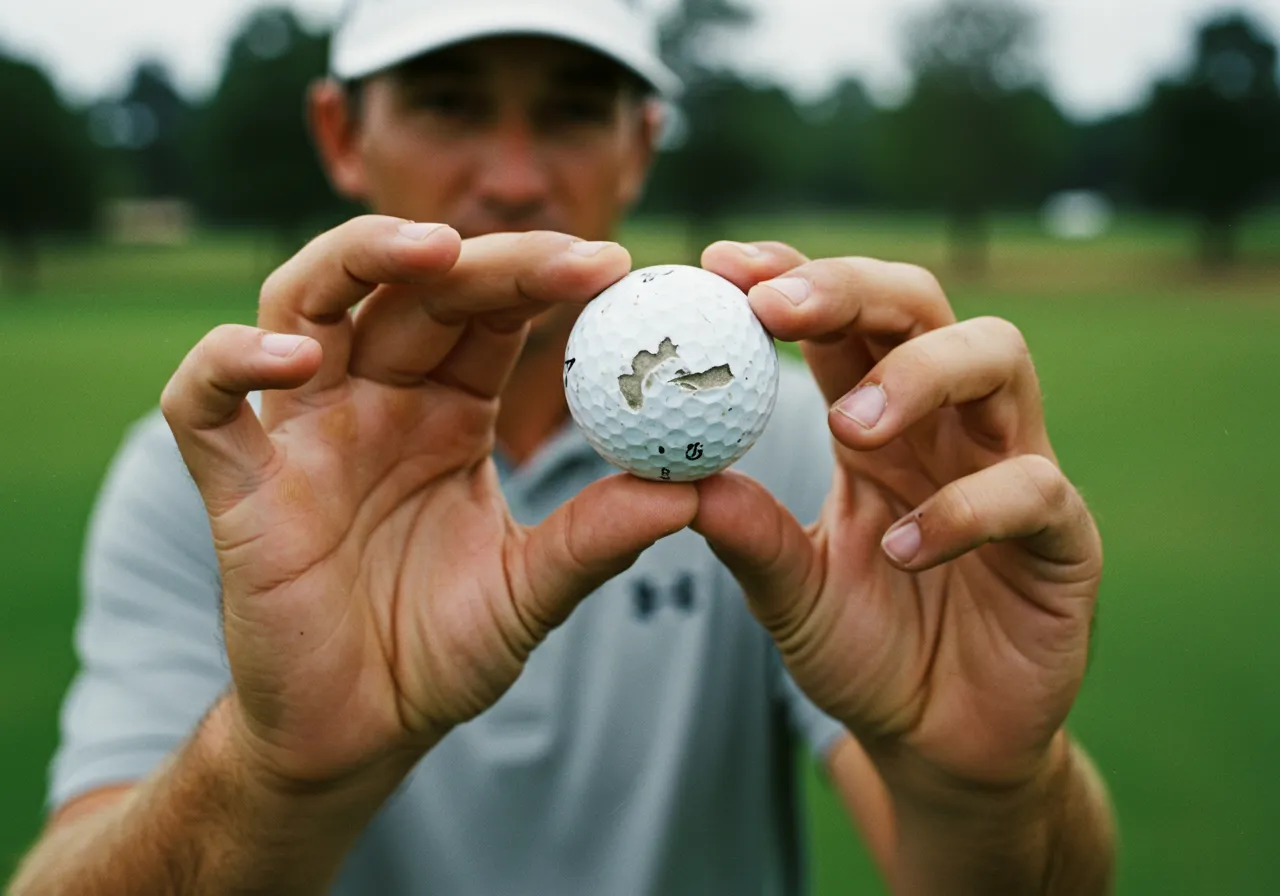
We hit so many shots that balls wear out fast, not just from use, but from hitting grooved wedges, bunkers, or even cart paths during practice.
In a full practice day, I might go through:
- 6 to 12 balls on the range
- Another 4 to 6 for short game work
- And a fresh sleeve (3 balls) for putting drills
Even though I don’t usually lose balls, the wear and tear from daily use means I need a constant supply of fresh ones.
How many golf balls do pro golfers lose during a tournament round
Believe it or not, I usually don’t lose any balls during a tournament round. Maybe 1 per tournament, and that’s only if I hit into a water hazard or out of bounds, which I try very hard to avoid.
That’s a big difference from amateurs. According to Quora and OutOfBoundsGolf, most casual players lose 5 to 12 balls per round, especially on tighter courses with trees, water, or long rough.
Here’s why pros lose fewer balls:
- We know how far every club goes
- We pick smart targets
- We avoid risky shots unless necessary
And yes, we still get mad when we lose one!
What everyday golfers can learn from how pros manage golf ball use

If you’re not on tour, you don’t need a new ball every few holes, but you should:
- Replace any ball that has scratches or cuts
- Check for damage after hitting a cart path or tree
- Use higher-quality balls if you want more distance control and spin
Also, don’t feel bad if you lose balls; we all started that way. The more you play with focus and smart club choices, the fewer balls you’ll lose over time.
Golf Ball Production and Usage: Pros vs Amateurs
| Category | Professional Golfers | Amateur Golfers |
| Balls Hit Per Day (Practice) | 500–1,200+ (includes short game, full swing, putting) | 50–200 (varies widely by skill and commitment) |
| Balls Lost Per Tournament | Less than 1 (usually from hazards or penalty areas) | 5–12 per round (especially on courses with trees or water) |
| Ball Replacement Reason | Wear from grooves, spin control loss, wedge abrasions | Lost in rough water or out of bounds |
| Range Usage per Day | 6–12 balls (rotation) + short game and putting drills | 20–100 balls (often less structured practice) |
| New Balls Per Tournament | Full sleeve (Pro V1, TP5x, Chrome Soft X) per round | Often use a mix of new and reused balls |
| Factory Production (Daily) | Titleist: 1.2M+, Callaway: 750K+ | Shared supply for pros and public; pro balls undergo more QA |
| Logistics Support | Personalized tour delivery (initials, preferred numbers) | Retail purchase or recycled balls from previous rounds |
Note: This table shows how pro golfers and amateur players differ in ball use and loss, not just in quantity but in quality, purpose, and precision.
How to Optimize Your Golf Practice Like a Pro Without Hitting 1,000 Balls

You don’t need to hit hundreds of balls a day to get better at golf. As a pro, I’ve learned that smart practice beats long practice.
If you’re a weekend golfer or trying to level up your game, there’s a way to get the most out of just 100 balls per session.
What is the best way to use 100 golf balls in a single practice session
Here’s how I break down my 100-ball practice plan, and it’s something I recommend to most players, even pros:
- 50 Balls: Technical Drills
These are swings where I focus on one move, like keeping my left wrist flat or fixing my takeaway. I might use alignment sticks or a training aid for shot accuracy drills. - 30 Balls: Shot Shaping Practice
These balls are for working the ball left or right, high or low, just like I’d need to do on the course. I focus on clubface control, path, and tempo. - 20 Balls: Pressure Simulation
I imagine I’m on the 18th hole, needing to hit a fairway or knock it close. This trains mental focus and decision-making, which matter as much as technique.
With this breakdown, I stay sharp, improve faster, and avoid burning out.
Why hitting more balls can hurt your swing and your wallet
When I was younger, I used to think that hitting 300 balls a day meant I was working harder. But I wasn’t getting better, I was just getting tired. That’s because muscle fatigue leads to bad habits.
Many Reddit users shared similar stories. After hitting too many balls, their swings got worse, not better, because they weren’t thinking clearly or swinging with good form. That’s how ingrained errors happen.
Also, think about the cost:
- At 300 balls a day, range fees or buckets can cost over $250/month
- At 100 smart balls per day, you save money and get better results
Less truly is more if you focus on quality.
How amateur golfers can practice with golf balls like pros without overtraining
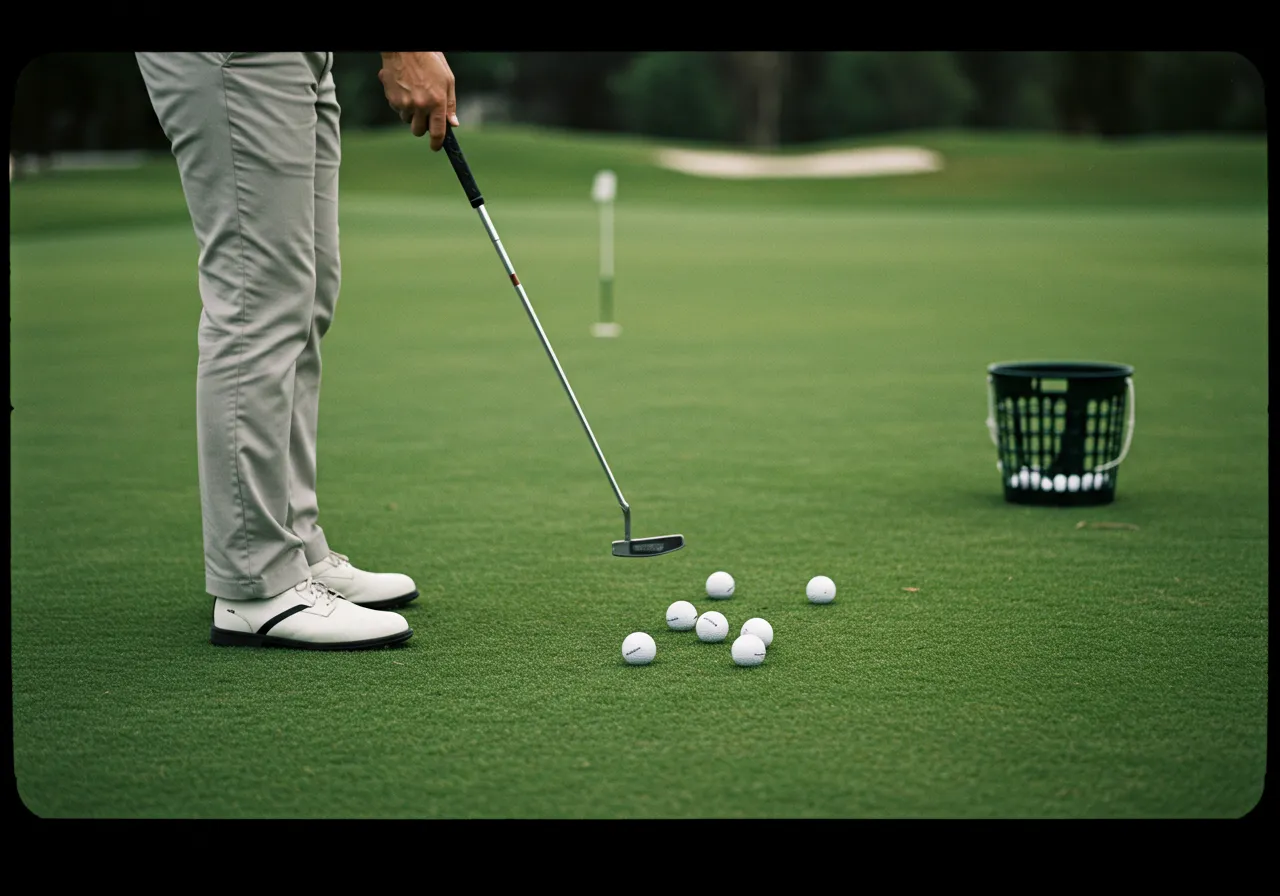
If you’re not on tour, here’s what I suggest:
- Plan each range session, don’t just hit and hope
- Use 100 balls wisely: warm-up, drills, shaping, pressure
- Stop when you get tired, don’t force swings
- Track your progress: what felt good, what needs work
This way, you’ll make real improvements without feeling worn out, and you’ll look forward to your next session.
FAQs
How many golf balls does a pro hit a day?
Most professional golfers hit 500 to 1,200 balls per day during training, focusing on full swings, short game, and putting. On tournament days, they reduce this to 60 to 100 balls to preserve energy and fine-tune rhythm.
How many golf balls should I hit at the driving range?
Amateur golfers should aim to hit 50 to 100 balls per session, with a mix of technical drills, shot shaping, and target-based practice. Focus on swing consistency and ball-striking quality, not just quantity.
Is hitting 1,000 golf balls a day good for improvement?
Not always. Hitting 1,000 balls without structure can lead to fatigue and bad swing habits. It’s better to hit fewer, focused shots using practice drills, launch monitor feedback, and proper rest intervals.
Why do pro golfers hit so many balls every day?
Pro golfers practice more to maintain swing mechanics, ball control, and muscle memory. High repetition helps build the myelin sheath in the brain, improving shot repeatability and performance under pressure.
How many golf balls does Tiger Woods hit in a day?
In his prime, Tiger Woods hit 800 to 1,200 balls a day, followed by 3 hours of putting. Today, after injuries, he limits practice to around 300 balls, focusing on short game precision and load management.
How many golf balls does Titleist make per day?
Titleist manufactures over 1.2 million golf balls daily at its factory in Perry, Ohio. These include the popular Pro V1 series used by many PGA Tour pros and elite amateurs.
How many golf balls does the average golfer lose per round?
Amateur golfers lose an average of 5 to 12 balls per round, depending on course difficulty and skill level. In contrast, pros typically lose less than 1 ball per tournament due to better accuracy and decision-making.
Conclusion
While pro golfers may hit 500 to 1,500 balls a day during practice, what really makes them better is how they practice.
They follow a plan, get help from coaches, and focus on improving each shot. From Tiger Woods’ long practice days to Scottie Scheffler’s smart warm-ups, every shot has a clear goal.
If you’re trying to break 90 or chase scratch, the smartest way to practice is with intent, feedback, and balance. Hitting more balls won’t fix your swing, but practicing the right way, like the pros do, absolutely will.
How Do Pros Warm Up Before a Round of Golf? How Many Balls Do They Hit
Posts References:
How many balls a day do I need to get good at golf
How often do you practice at the range